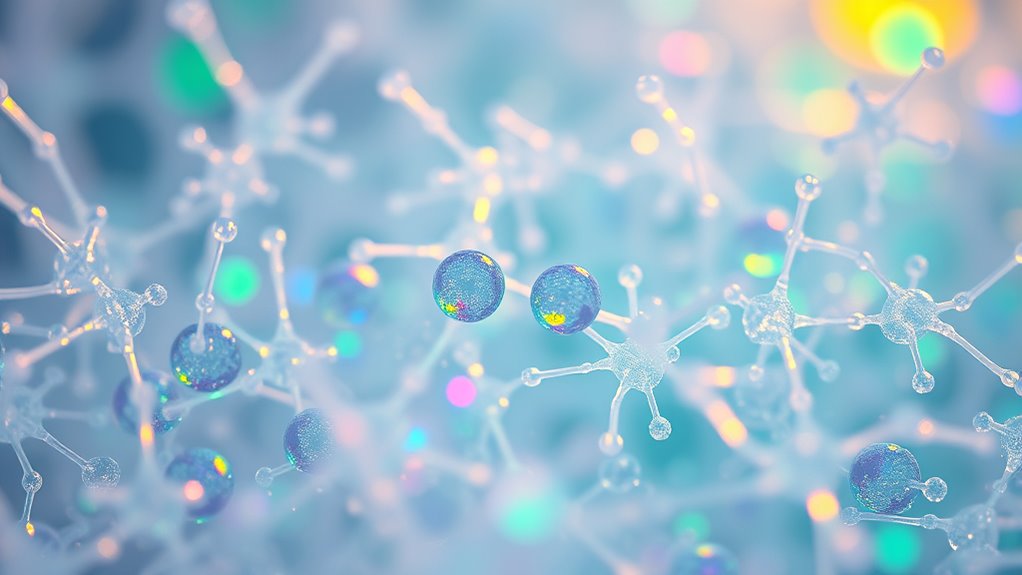Nanomedicine uses tiny, engineered particles to target and treat diseases at the molecular level. These nanoparticles are designed to locate, interact with, and deliver drugs directly to specific cells or tissues, increasing treatment effectiveness. They help minimize side effects by focusing only on diseased areas. If you want to understand how these advances can revolutionize healthcare and improve outcomes, there’s much more to explore behind the science.
Key Takeaways
- Nanomedicine employs engineered nanoparticles to target diseased cells precisely at the molecular level.
- It enables controlled drug release directly at disease sites, enhancing treatment effectiveness.
- Surface properties and material choice influence nanoparticle interactions with biological systems.
- Innovations include using lipids, polymers, and inorganic compounds for improved delivery and stability.
- Future prospects involve personalized, molecular-level treatments with fewer side effects and faster recovery.

Have you ever wondered how tiny particles are transforming medicine? It’s all thanks to the incredible field of nanomedicine, where scientists manipulate matter at the molecular level to develop innovative treatments. At the heart of this revolution is nanoparticle design, which involves creating minuscule particles that can navigate the body with precision. These nanoparticles are engineered to interact specifically with diseased cells, making treatments more effective and reducing side effects. By tailoring their size, shape, and surface properties, researchers can optimize how these particles behave in the bloodstream and target tissues. This meticulous design is essential for developing advanced drug delivery systems that can carry medications directly to where they’re needed most.
With these sophisticated drug delivery systems, you’re no longer limited to traditional methods like pills or injections that distribute drugs broadly throughout the body. Instead, nanoparticles can act like guided missiles, honing in on cancer cells, infections, or inflamed tissues with remarkable accuracy. Once they reach their target, these particles release their payloads in a controlled manner, ensuring the medicine acts precisely at the site of disease. This targeted approach not only boosts treatment efficacy but also minimizes damage to healthy cells, reducing adverse effects often associated with conventional therapies. Imagine a world where chemotherapy affects only cancer cells, sparing your healthy tissues — that’s the promise of nanoparticle-based drug delivery systems.
Designing these nanoparticles involves understanding how they interact with biological environments. Factors like surface chemistry influence how long they circulate in the bloodstream, how they evade the immune system, and how they release their drugs. Researchers are constantly refining nanoparticle design to improve stability, biocompatibility, and targeting accuracy. They’re also exploring new materials, including lipids, polymers, and inorganic compounds, to expand the possibilities of nanomedicine. Additionally, advances in targeted drug delivery are enabling more precise treatments tailored to individual patients. As these technologies advance, you could see personalized treatments tailored to your unique genetic makeup, delivered directly to your cells at the molecular level. This means faster recovery times, fewer side effects, and more effective management of chronic and complex diseases.
Frequently Asked Questions
How Long Does It Take for Nanomedicine Treatments to Develop Clinically?
You might wonder how long nanomedicine treatments take to develop clinically. Typically, it can take 10 to 15 years, considering clinical trial timelines and the regulatory approval process. You’ll see multiple phases of testing, safety evaluations, and efficacy assessments before approval. The process is thorough to guarantee safety and effectiveness, so patience is key. Overall, this rigorous journey aims to bring innovative treatments safely to patients like you.
Are There Any Known Long-Term Health Risks of Nanomedicine?
You might wonder if nanomedicine has long-term health risks. While research is ongoing, some biocompatibility concerns exist, like how nanoparticles interact with your body over time. Scientists also study environmental impacts from manufacturing and disposal. Though no definitive risks are confirmed yet, staying informed helps you understand potential hazards. Continued research aims to ascertain nanomedicine’s safety, addressing these concerns before widespread use.
What Are the Current Challenges in Nanomedicine Manufacturing?
You face challenges in nanomedicine manufacturing, especially with scaling issues, as producing consistent, large-scale nanomaterials is complex. Ensuring quality control is also tough because even tiny variations can impact safety and effectiveness. These hurdles require advanced techniques and rigorous testing. Overcoming them is essential for reliable, widespread use. By addressing these issues, you can improve manufacturing processes and bring innovative nanomedicine treatments to patients more efficiently.
How Affordable Are Nanomedicine Therapies for Patients Worldwide?
You might wonder how affordable nanomedicine therapies are for patients worldwide. Currently, cost barriers limit access due to complex manufacturing and high development expenses. These factors make nanomedicine less globally accessible, especially in low-income regions. While advancements are reducing costs, achieving widespread affordability remains a challenge. Efforts to streamline production and improve distribution are essential to guarantee more people can benefit from these innovative treatments.
Can Nanomedicine Be Used to Treat Genetic Disorders Effectively?
Imagine revealing the secrets of your DNA’s code—that’s what nanomedicine aims to do. You can see gene editing and molecular targeting working together to treat genetic disorders effectively. By delivering precise therapies directly to affected cells, nanomedicine offers hope. While still evolving, its potential to correct genetic flaws at the molecular level promises a future where treatments are more personalized, efficient, and less invasive.
Conclusion
Now that you’ve explored nanomedicine, you realize you’re on the brink of a medical revolution that could change everything. By targeting diseases at the molecular level, you’re holding the power to cure illnesses once considered unbeatable. With this incredible technology, the future isn’t just bright — it’s brighter than a supernova, promising health miracles that might have once seemed impossible. Embrace this tiny but mighty world, because it’s shaping the future of medicine in ways you’ve never imagined.









